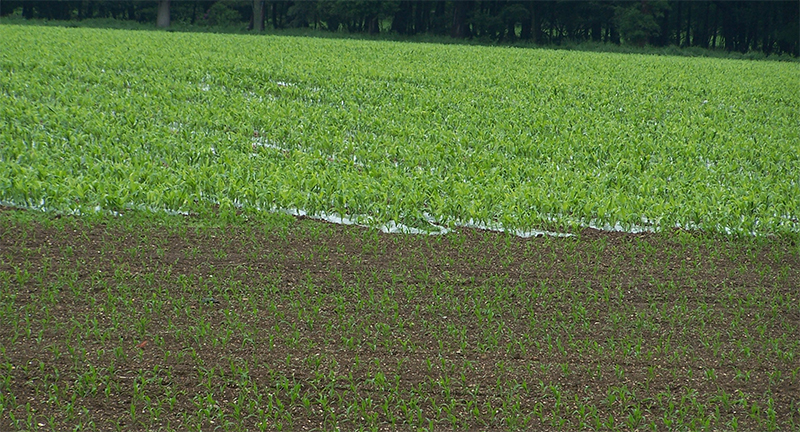
Growers are urged not to use arbitrary ‘safe sowing dates’ when deciding the best time to drill maize as soil temperature is extremely important for the early development of the crop.
“Maize is very sensitive to soil temperature as it needs quick, uninterrupted germination and growth. Growers need to wait for a period of consistent soil temperature above eight degrees Celsius in order to ensure germination. I would urge growers to be patient and not go to drill too early, one of my highest yielding fields in 2014 wasn’t drilled until June,” says Hutchinsons maize specialist Ed Stevens.
“It is understandable for growers to want to start drilling early, particularly where they have a large area to cover, but it’s really important to wait for the soils to warm up, particularly on heavier land.”
There are tools available to assess soil temperature such as the KWS Live Maize Soil Temperature Service which can be found on their web site.
Consider a range of different varieties.
“We see many growers this year making very careful decisions when it comes to variety choice and ensuring that there is a spread of different maturity rates and genetics particularly where there is a large area to be planted,“ says Hutchinsons Seed Manager Colin Button.
“Another consideration to be aware of is that seed rates should be decreased the later one sows which is counter-intuitive to many growers who are used to upping the seed rate in cereals for example.”
Wireworm challenge
Increased risk of wireworm, especially in maize after grass, set-aside, or close to 6m margins is a strong reason for delaying drilling this spring, says Mark Orton, regional director at Shropshire-based, Hodges & Moss.
“The loss of clothianidin seed treatments following the two-year ban on certain neonicotinoids has left growers with a dilemma as the replacement seed dressing for wireworm based on the active thiacloprid cannot be co-applied with methiocarb used as a bird repellant, so wireworm control where birds are an issue will rely heavily on cultural methods,” he says.
Placement fertilisers offer benefits
Starter fertilisers are common practice in maize and there are consistent benefits to placing soluble phosphate based fertilisers at drilling.
Granular products such as DAP and MaxiMaize, or the microgranular product Primary P help to ensure nutrient availability is not compromised in cold or dry soil conditions.
“Placement fertilisers help to overcome the immobility of phosphate in the soil” says fertiliser manager, Tim Kerr. “Maize plants take up half the nitrogen that they use through July and August – often 4 months after nitrogen fertiliser is applied.”
“One option which has proved very successful is the use of the nitrification inhibitor NLock. This product helps to stabilise the soil nitrogen and extend the period of availability. Encouraging trials in the UK in 2014 showed an average yield response of 13% where NLock was used.”
Another option worth considering is using slow release foliar N product Efficient-N 28 later in the season, adds Mark Orton. “The nitrogen in the product is used much more efficiently and it’s formulation delays nitrogen availability over a longer period than AN. You can apply it as late as you can feasibly travel through the crop.”
The growing threat of eyespot
An additional and increasing threat to maize crops is eyespot, and the disease could warrant control later in the season, says Mr Stevens.
“It is generally more of an issue in western parts of the UK, where many crops are treated as a matter of course, but wet weather during late spring/summer could favour its development almost anywhere.”
“Eyespot requires the leaf to be wet for at least six hours in order for the pathogen to get into the plant, so it does have to be quite wet for it to be an issue. If the weather is wet and you’ve got a susceptible early variety then it’s probably worth treating, but you’ve got to do it before the eight to nine-leaf stage as that’s the last time you can get through the crop.”
Recently certain pyraclostrobin-based products have been granted Extensions of Authorisation for minor use (EAMU) for use in maize to control eyespot he notes. “There is also a full label approval for an azoxystrobin/propiconazole mix.
These may be applied as a single spray or a two-spray sequence, ideally at the 4-8 leaf stage, followed by a second application during tasselling. These sprays have also been found to increase green leaf area and photosynthesis as well as increasing cob size and quality leading to increased yield.”
Beware herbicide residues in digestate
It should be noted there are a wide range of herbicides for use in maize now, but care should be taken when selecting products, particularly in AD crops is the advice from Mr Stevens.
“On two levels firstly no products containing clopyralid should be used, as this can lead to issues with where the digestate can be used, as it is not broken down in the AD process. The second is following high value crops in some areas, here one needs to check product labels, or discuss with your agronomist.”
